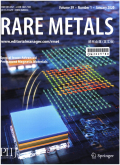- 钛学术文献服务平台 \
- 学术期刊 \
- 工业技术期刊 \
- 冶金工业期刊 \
- 稀有金属(英文版)期刊 \
Photocatalytic and photochemical processes of AgCl/TiO2 studied with a fully integrated X-ray photoelectron spectrometer
Photocatalytic and photochemical processes of AgCl/TiO2 studied with a fully integrated X-ray photoelectron spectrometer
基本信息来源于合作网站,原文需代理用户跳转至来源网站获取
摘要:
A fully integrated X-ray photoelectron spectrometer (XPS) was employed for the investigation of the separation processes and recombination behaviors of photogenerated electrons and holes on the surface of AgCl and ultra-small nano-titanium oxide cluster composite photocatalyst (AgCl/TiO2).A facile route,by direct colloidal synthesis,for preparing AgCl/TiO2 with high stability and enhanced visible light (Vis) driven catalytic activity was reported.The photocatalytic activity of AgCl/TiO2,which revealed that the photo-degradation rate of the as-prepared AgCl/TiO2 was nearly 10.5 times higher than that of bare AgCl,was evaluated by applying it to the photo-degradation of methyl orange (MO) in water solution.Moreover,AgCl/TiO2 exhibited an outstanding long-term stability during ten cycles of photo-degradation.The band gap of AgCl decreased from 3.25 to 2.85 eV because of the ultrasmall nano-TiO2 clusters that were pinned to its surface.The results indicate that the band gap narrowing and surface plasmon resonance (SPR) of Ag (0) were two major contributors to the enhancement of the photocatalytic activity of AgCl/TiO2 by improving the utilization of Vis.In situ XPS analysis was,therefore,certified as a beneficial method to explore the catalytic mechanism of photocatalysts.

推荐文章
低能量X-RAY测厚仪与β-RAY
测厚仪
薄膜
应用
比较
高分辨X-RAY成像系统的搭建及其血管造影研究
血管造影
后肢缺血模型
高分辨率X光机
TiO2-AgCl光催化氧化分解水中有机物的研究
TiO2-AgCl
光催化氧化
活性深蓝K-2GE
UV
溶胶-凝胶制备纳米TiO2的X射线衍射分析
溶胶-凝胶法
TiO2
纳米粉体
薄膜
内容分析
关键词云
关键词热度
相关文献总数
(/次)
(/年)
引文网络
引文网络
二级参考文献 (97)
共引文献 (2)
参考文献 (26)
节点文献
引证文献 (0)
同被引文献 (0)
二级引证文献 (0)
1972(3)
- 参考文献(0)
- 二级参考文献(3)
1982(1)
- 参考文献(0)
- 二级参考文献(1)
1985(1)
- 参考文献(1)
- 二级参考文献(0)
1991(1)
- 参考文献(0)
- 二级参考文献(1)
1994(1)
- 参考文献(0)
- 二级参考文献(1)
1996(1)
- 参考文献(1)
- 二级参考文献(0)
1998(1)
- 参考文献(0)
- 二级参考文献(1)
1999(2)
- 参考文献(1)
- 二级参考文献(1)
2000(1)
- 参考文献(1)
- 二级参考文献(0)
2001(3)
- 参考文献(1)
- 二级参考文献(2)
2003(4)
- 参考文献(0)
- 二级参考文献(4)
2004(2)
- 参考文献(1)
- 二级参考文献(1)
2006(3)
- 参考文献(1)
- 二级参考文献(2)
2007(2)
- 参考文献(0)
- 二级参考文献(2)
2008(5)
- 参考文献(1)
- 二级参考文献(4)
2009(7)
- 参考文献(0)
- 二级参考文献(7)
2010(12)
- 参考文献(1)
- 二级参考文献(11)
2011(10)
- 参考文献(2)
- 二级参考文献(8)
2012(13)
- 参考文献(0)
- 二级参考文献(13)
2013(8)
- 参考文献(2)
- 二级参考文献(6)
2014(10)
- 参考文献(1)
- 二级参考文献(9)
2015(10)
- 参考文献(1)
- 二级参考文献(9)
2016(6)
- 参考文献(0)
- 二级参考文献(6)
2017(2)
- 参考文献(1)
- 二级参考文献(1)
2018(6)
- 参考文献(2)
- 二级参考文献(4)
2019(6)
- 参考文献(6)
- 二级参考文献(0)
2020(2)
- 参考文献(2)
- 二级参考文献(0)
2021(0)
- 参考文献(0)
- 二级参考文献(0)
- 引证文献(0)
- 二级引证文献(0)
引文网络交叉学科
相关学者/机构
期刊影响力
稀有金属(英文版)
主办单位:
中国有色金属学会
出版周期:
月刊
ISSN:
1001-0521
CN:
11-2112/TF
开本:
16开
出版地:
北京学院路2号
邮发代号:
创刊时间:
1989
语种:
eng
出版文献量(篇)
2804
总下载数(次)
0
总被引数(次)
9706
期刊文献
相关文献
推荐文献
- 期刊分类
- 期刊(年)
- 期刊(期)
- 期刊推荐
一般工业技术
交通运输
军事科技
冶金工业
动力工程
化学工业
原子能技术
大学学报
建筑科学
无线电电子学与电信技术
机械与仪表工业
水利工程
环境科学与安全科学
电工技术
石油与天然气工业
矿业工程
自动化技术与计算机技术
航空航天
轻工业与手工业
金属学与金属工艺
稀有金属(英文版)2022
稀有金属(英文版)2021
稀有金属(英文版)2020
稀有金属(英文版)2019
稀有金属(英文版)2018
稀有金属(英文版)2017
稀有金属(英文版)2016
稀有金属(英文版)2015
稀有金属(英文版)2014
稀有金属(英文版)2013
稀有金属(英文版)2012
稀有金属(英文版)2011
稀有金属(英文版)2010
稀有金属(英文版)2009
稀有金属(英文版)2008
稀有金属(英文版)2007
稀有金属(英文版)2006
稀有金属(英文版)2005
稀有金属(英文版)2004
稀有金属(英文版)2003
稀有金属(英文版)2002
稀有金属(英文版)2001
稀有金属(英文版)2000
稀有金属(英文版)1999
稀有金属(英文版)2021年第8期
稀有金属(英文版)2021年第7期
稀有金属(英文版)2021年第6期
稀有金属(英文版)2021年第5期
稀有金属(英文版)2021年第4期
稀有金属(英文版)2021年第3期
稀有金属(英文版)2021年第2期
稀有金属(英文版)2021年第12期
稀有金属(英文版)2021年第1期

 免费查重
免费查重










